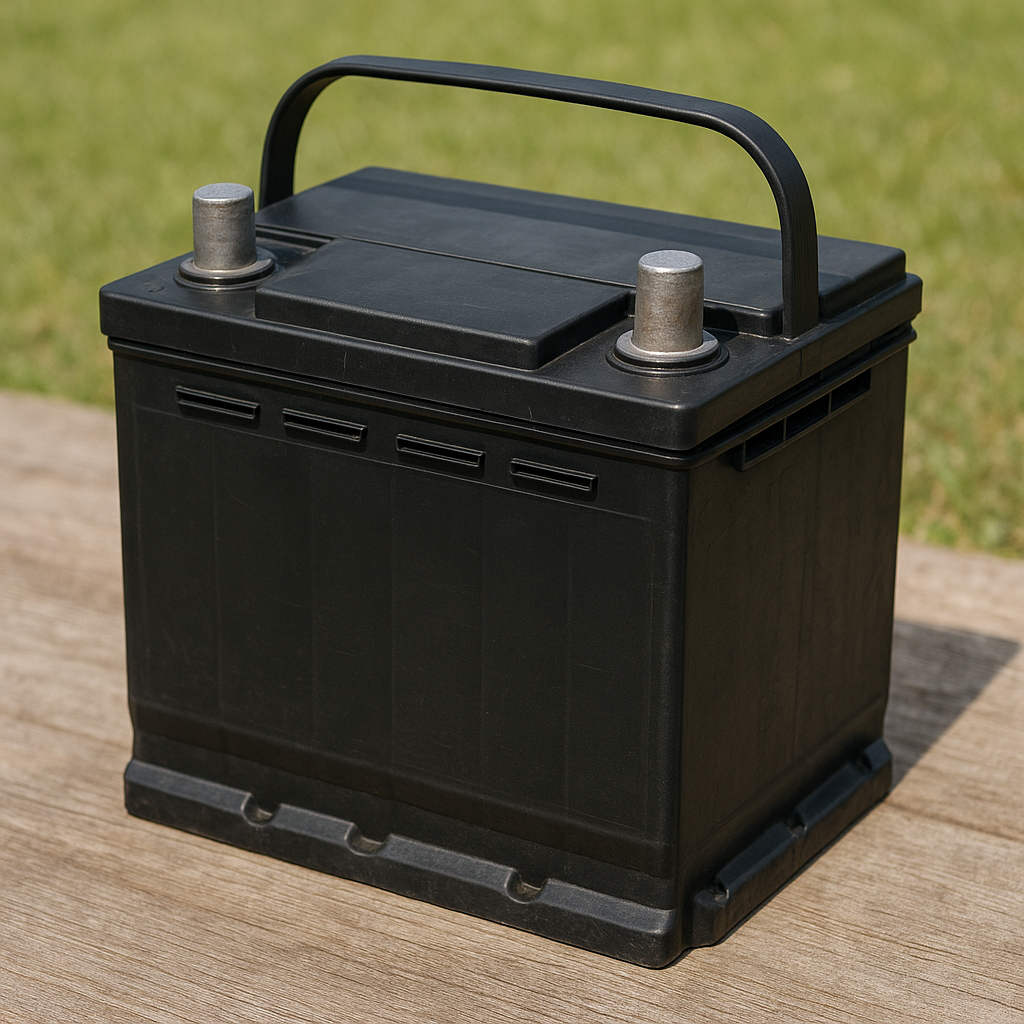Battery tenders keep your batteries stable when they are not being used. They can prolong your batteries’ lifespan and keep them safe by maintaining a minimum charge, avoiding overcharging or discharging, which can damage the battery. Using a solar battery tender can be a more sustainable way to keep the charge, rather than using other electrical means that are not as clean.
What is a Solar Battery Tender?
If a battery is not being used (charged and discharged), it will slowly lose its charge over time.
A battery tender, also sometimes called a battery maintainer or a float charger, keeps a minimum charge in a battery while the battery is not being used. This helps to prolong the battery’s life.
Battery tenders are slightly different from regular battery chargers and trickle chargers because they have a processor onboard. This processor regulates how and when battery charging occurs. A regular battery charger is likely to continue supplying current to a battery as long as it is connected. The same could happen with a solar trickle charger, leading to overcharging batteries. When a battery is overcharged, it can boil the electrolyte. As a result, the battery could fail, or, worse, a fire or explosion could occur.
The built-in processor on a battery tender prevents overcharging of the battery. It will also stop the battery tender from charging a faulty battery. More than that, a battery tender employs spark-free technology and has indicator lights that quickly show you the system’s status. While some battery maintainers only have red and green lights to indicate the system’s status, others could display the battery’s state of charge as a percentage and show when the battery is not charging correctly.
Some maintenance chargers desulfate and clean battery plates. This renews and restores them and helps to extend the battery lifespan.
Battery tenders are not the best product to use if you need to jump-start a dead battery, in that case you would need a trickle charger. The good news though is that the point of a battery tender is to not allow the battery to die in the first place (but it’s never a bad idea to be prepared).
Most battery tenders need to be plugged into an alternating current (AC) outlet or cigarette lighter plug and connected to the battery. The tender then transfers power from the outlet to your battery. Solar battery tenders do not need to be plugged into an outlet. Instead, the battery tender solar panel harvests the energy of the sun to produce the current that will keep your battery charged.
Why Do I Need to Maintain My Solar Batteries?
Regardless of the battery type, whether it is a boat battery, car battery, or even an RV battery, keeping them maintained lengthens their lifespan. It also avoids you unexpectedly finding a dead battery and minimizes any safety issues that may arise from poorly maintained batteries.
When a lead acid battery is stored for an extended time, and the charge drops lower than a certain percentage, lead sulfate crystals can build up on the battery cell. This is called sulfation and happens to all batteries. Still, this build-up can occur quicker when a battery is not being used or if the battery is regularly over or undercharged.
The sulfate builds up on a battery will make the battery less effective and efficient. It will shorten the battery life and could affect the battery’s running time, how long it needs to become fully charged and how long it can hold a charge. Sulfation can also lead to the loss of cranking power and cause any connected devices to overheat.
Sulfation can be prevented by keeping your lead acid battery charged and avoiding leaving it discharged for extended periods. Most lead acid batteries should have a minimum charge of about 60-70% when not in use. Follow the manufacturer’s recommendations to get the most use out of your battery.
In addition to keeping your battery charged, you can use a battery maintenance charger that uses a desulfating pulse. This automatically cleans any sulfate build-up from the battery plates. In some cases, regularly desulfating your battery could extend its life cycles by up to five times.
Lithium-ion batteries will also benefit from being connected to a solar battery tender while not in use. These batteries should be stored with at least a 40% charge to prevent them from going into sleep mode. This usually occurs when the battery drops to below 2.5 Volts per cell.
A lithium-ion battery will have to be discarded if it has been stored at below 2 Volts per cell for more than a week or if it does not charge efficiently after it has been stored.
If a lithium-ion battery becomes too deeply discharged, it can become unstable. Microscopic metal crystals can form in the cell, which could lead to short circuits and overheating. This could cause a fire or explosion.
While you can get some analyzers and chargers that can boost and wake up a lithium-ion battery, keeping it connected to a battery maintainer could help avoid a potentially dangerous situation.
How Does a Solar Battery Maintainer Work?
A solar battery maintainer is a plug-and-play product that can be connected to a battery indefinitely. The processor monitors the battery charge and stops the charge current to allow the battery to settle. When it detects that the battery’s voltage drops below a specified level, the charger will automatically turn on to charge the battery.
Unlike regular battery tenders, solar battery tenders do not need to be connected to a power outlet to work (although some also have this feature). Instead, they function as mini solar battery chargers to generate their own power, which will then be used to charge your battery as and when needed.
Solar battery tenders have a built-in solar panel that consists of a number of solar cells that produce clean energy. Some battery maintainers can be hardwired to your battery for a permanent solution. Alternatively, you can use the alligator clips to connect the solar battery maintainer to your battery only when you need to use it.
Most solar battery maintainers are either waterproof or water-resistant. This makes them ideal for outdoor use or to keep the batteries of watercraft charged during times when they are not being used.
Keep in mind that solar battery maintainers will only generate power while they are exposed to direct sunlight. That means these devices may be less efficient on cloudy days or when they are in the shade and won’t produce any current during the night. A solar battery tender with a built-in circuit breaker will prevent the battery from discharging into the solar panel at times when the solar battery tender is unable to generate a current.
How Do You Use a Battery Tender?
Most solar battery tenders are plug-and-play. That means you simply need to connect the device to your battery and leave it to do its job. The battery tender should automatically detect the battery’s charge level.
Some battery tenders allow you to select the minimum voltage to which the battery’s charge level can drop. When the charge level drops down to this, the battery maintainer will engage and charge the battery.
Once the battery is charged, the battery tender will cease the flow of current to avoid overcharging the battery. In some cases, the battery will be fully charged. In others, you may be able to set the battery tender to charge your battery to a level that you select when you set it up.
How Much Does a Solar Battery Tender Cost?
The cost of a solar battery tender can vary substantially. Low-end models can cost as little as $20, while higher-end products could cost up to around $200. The price of a solar battery tender is affected by the size and construction of the solar panel. As a result of this, solar maintainers that produce a higher wattage tend to be more expensive.
The price is also affected by the features and accessories included with the product. Solar battery tenders that offer a more extensive range of features (like showing the battery’s charge level) will be more expensive than those with more basic features.
Is it Worth Investing in a Solar Battery Tender?
The short answer is yes. A solar battery tender keeps your battery safe when it isn’t in use. It offers overcharge protection. Overcharging could happen when you leave a battery connected to a charger indefinitely. It also prevents your battery from draining completely. Both of these situations could decrease the lifespan of your battery, or worse, cause damage to your battery and even lead to a fire or explosion.
Using a solar battery maintainer means you don’t need to use (and pay for) grid electricity to keep your batteries at optimum charge when they are not in use. Besides being more cost-effective, these solar energy battery tenders allow you to harness renewable energy to keep your batteries in optimum condition.
Check us out at Homeowner.org for more on home improvement. We’re here to be your ultimate resource as a homeowner!



